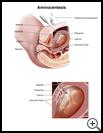
Fetal Lung Maturity Test
________________________________________________________________________
KEY POINTS
- A fetal lung maturity test checks your baby's lungs to see if the baby will be able to breathe OK if he or she is born early.
- A very thin needle is used to remove a small amount of fluid from the amniotic sac. The amniotic sac is the bag of fluid that surrounds the baby.
- Talk to your healthcare provider about what the test results mean and ask any questions you have.
________________________________________________________________________
What is a fetal lung maturity test?
The lungs are the last organs to mature in a baby before birth. A fetal lung maturity test checks your baby's lungs to see if the baby will be able to breathe OK if he or she is born early. A very thin needle is used to remove a small amount of fluid from the amniotic sac. The amniotic sac is the bag of fluid that surrounds the baby.
When is it used?
This test is done if your baby may need to be delivered early. Babies usually start making a substance called surfactant sometime between the 30th and 36th weeks of pregnancy. Surfactant will help keep the air sacs in the lungs from sticking to each other when your baby starts breathing after birth. The fluid around the baby shows how much surfactant your baby has. The fluid is tested in the lab to see if your baby has enough surfactant to breathe after birth.
The test results help your healthcare provider know if the baby could have problems breathing after birth. Your provider may decide not to deliver the baby until the lungs are more mature. You may be given a medicine to help your baby’s lungs mature more quickly.
How do I prepare for this test?
Follow any other instructions your healthcare provider gives you. Talk to your provider if you have any questions about the test.
What happens during the test?
The baby's heart rate is checked before and after the test. Your belly is cleaned with a solution that prevents infection. Your healthcare provider uses ultrasound images to help guide a thin needle through your belly, into the uterus, and to the area where the most amniotic fluid is. Like when you have your blood drawn, you may feel some brief, mild discomfort from the needle. Your provider will use the needle to get a small amount of fluid for lab tests.
If you are pregnant with more than 1 baby, a sample of fluid may be taken with different needles from each baby's amniotic sac.
What happens after the test?
Your pulse, your blood pressure, and the baby's movements will be watched for a brief time after the test. You may go home after the test or you may stay in the hospital if your baby needs to be monitored. You should rest for 24 hours after the test.
The results of the test should be available in a day. Ask your healthcare provider:
- How and when you will get your test results
- How long it will take to recover
- If there are activities you should avoid and when you can return to your normal activities
- How to take care of yourself at home
- What symptoms or problems you should watch for and what to do if you have them
Make sure you know when you should come back for a checkup.
What are the risks of this test?
Every procedure or treatment has risks. Some possible risks of this procedure include:
- Infection or bleeding
- Harm to the baby, placenta, or umbilical cord by the needle
- Early breaking of the amniotic sac (also called the bag of water)
- Going into labor early
- Damage to a nearby organ
Ask your healthcare provider how these risks apply to you. Be sure to discuss any other questions or concerns that you may have.

